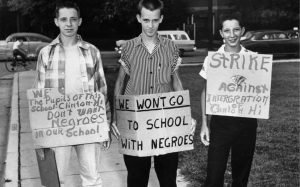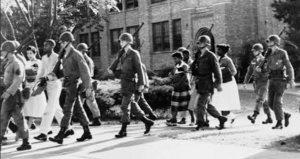America: Black people in the 1950’s
In the 1950s, life in the U.S was still quite segregated. To further understand this conflict it is good to note the history of racial bias in America (mostly in the south). White Americans harbored a lot of hate towards black people with laws like the Jim Crow laws.
Jim Crow is a fictional character that comes from a song where people who were black were stereotyped and so they named the laws after the mockery that was represented in the song. These laws were full of things such as black people and white people not drinking from the same water fountains and black people not using the same bathrooms as white people. I also looked into the politics at the time, where whigs were racist, and republicans represented more people. After some time, the whig party collapsed and as republicans became more concerned with the business aspect and power, they completely disregarded the black people who voted for them at the start and so white Americans started to be republican, and democrats started listening to minority groups and started the movement for hispanic people and black people. This is similar to the way republicans and democrats are today.
The 1950s were when black people and their struggle were a big part of day to day American life. By 1954, the Brown v. Board of education ruled that black children and white children should learn in the same environment and that black people’s facilities were “inherently unequal”, and so Jim Crow laws were becoming a less dominant feature in the U.S. This made White Americans furious, and many started a revolt, so much so that the first black children to enter an all-white school had to be escorted to school by the army because people threw acid on them and spit on them. By 1955, Rosa Parks had been arrested for refusing to get up on the bus for a white person to sit down, and this made national headlines. People were boycotting buses and establishments that supported this, which was a base for the 1960s and the black movement then, where people and events like Martin Luther King Jr. and the Selma march for black voting rights came about. In a way, the 1950s were a small step towards more equal rights for black and white people.
Eilis and her opportunities:
Eilis was lucky in comparison to many other immigrants trying to get into the U.S at that time. She had everything arranged for her by a priest, and although she was Irish, which was still perceived as different, she was still white. She went into the U.S. with a fresh mindset as well, so she had not ever seen black people, and she did not fully understand why people were as racist as they were to begin with. Furthermore, she went to night classes which I can assume were full of different kinds of white people but no black people. I came to that conclusion because the first time she dealt with an African American was in Bartocci’s, and when she mentioned the “diversity” in her class she mentioned jewish people and Italians but not black people. She had a relatively easy experience compared to most immigrants because on her way there she also had someone to guide her and give her tips, and a job and a home.




